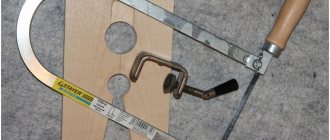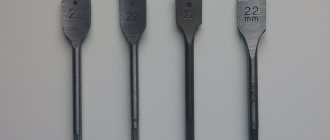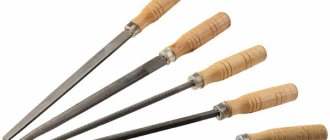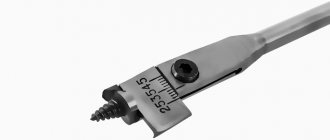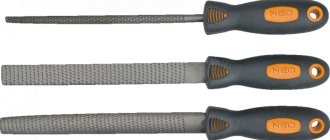Feather (feather) drill - used for drilling wood (solid wood, MDF, plywood), as well as plastic and drywall. Well suited for blind holes with no exit, such as mounting hinges, interior doors and through holes for various threaded connections.
Drilling occurs at a low speed of no more than 500 rpm; it is better to use a screwdriver or drill with a power regulator for these purposes.
When choosing, you should pay attention to how many drills are in the set, the standard size, and what kind of shank (hexagonal or cylindrical). drill material and its coating.
Application area
The tool is used when working with all types of wood, as well as its derivatives (MDF, chipboard, plywood). It is equally widely used for repairs, in the manufacture of furniture, doors, window frames, and in other areas of industrial production. There are two main types of drilling in which it is used:
- For non-through holes of small diameter. For example, the production of fastening sockets for door jambs, furniture production.
- For through holes. For example, sockets for installing studs and other fasteners.
Important! Spade wood drill bits are recommended for shallow drilling. You also need to remember about the thin tip. It goes deeper into the wood than the main head.
Usage algorithm
There are a number of recommendations that should be followed when working with feather drills:
- Before starting work with the hole, you need to make markings on the wooden surface. This is the point where the Point is inserted. Before drilling, you need to deepen the point using a core.
- To work with the pen, you need to have an adjustable drill at your disposal. This is especially important when you need to work with several hole diameters. The rotation speed must be inversely proportional to the diameter of the drill, otherwise it may break if the speed is too high.
- When working with deep holes, it is important to also have an extension included with the drill, which helps increase the useful penetration depth by up to 30 millimeters.
- Before going deeper into the wood, you need to use cutters to outline the circle of the hole. To make a clear mark, it is important to enter the wood at low speeds. It is very important to maintain a vertical position when deepening, while pressing on the tip with little effort.
- When working with a feather, it is important to manually remove wood dust and sawdust from the hole, since the design does not allow them to be automatically removed after cutting. To do this, it is worth stopping work from time to time and removing it from the hole.
Design features
The uniqueness and efficiency of feather drills lies in their design simplicity. They consist of two parts:
- The working part is the main part of the tool that comes into contact with the wood being processed. The shape resembles a shovel with a sharp tip. He is responsible for the exact position of the blade and cuts out the main part of the wood. On the sides of the working surface there are blades and cutting edges. If you look at the longitudinal section, they are sharpened to the right side.
Feather drills for wood are made according to strictly verified patterns. The proportional ratio of the width and thickness of the working part is strictly observed:
| Width (diameter) | Thickness |
| Up to 1 cm | Up to 2 mm |
| Up to 2 cm | Up to 4 mm |
| Over 2 cm | Up to 8mm |
- tail - a steel rod in the shape of a hexagon. The multi-faceted configuration allows you to securely attach it to the drill chuck, as well as use adapters to increase the working depth.
Main characteristics
When using pen drills for wood, it is advisable to know how they differ from other types of cutting tools and what advantages they have.
Comparison with other types of instruments
Like metal drills, tools designed for woodworking are available in various designs and, accordingly, differ from each other in characteristics and functionality. When choosing such tools, you should have an idea of the advantages and disadvantages they have.
Table 1. Comparison of different types of wood drills
Feather drills, as can be seen from the table presented, have a number of advantages when compared with other types of tools. Meanwhile, a pen-type tool is not recommended for making large-diameter holes (more than 60 mm), since their edges may turn out torn. For such purposes, it is better to use core drills, which are made in the shape of a metal cup with cutting teeth located on its end part.
A pen with a threaded tip is more suitable for working on a machine: it drills faster, but the hole may end up oval-shaped if the part is not secured with clamps
Due to the low cost of feather drills for wood, any home craftsman can purchase a set of them. Having such a set in your home workshop makes it easy and quick to select a tool for drilling holes of different diameters.
Design Features
The tip drill has a very simple design, the elements of which are the working and tail parts.
Feather drill design
The working part is a flat blade, in the center of which there is a sharp protrusion used to center the hole being made. On the working part of the pen drills there are two cutting blades located on either side of the central protrusion. Each of these blades starts from the tip of the central protrusion and reaches one of the edges of the working part. The tilt of sharpening the blades of feather drills for wood, if you look at their working part in cross section, is done to the right. When making drills of this type, manufacturers adhere to certain ratios between the thickness and width of the cutting part.
Table 2. The ratio of the thickness and width of the cutting element of the drill
The tail part is made in the shape of a hexagon. This cross-sectional shape allows not only to securely fix the tool in the chucks of drills and screwdrivers, but also to use magnetic adapters and extensions for these purposes.
The simplicity of the design, which distinguishes drills related to pen drills, the absence of spiral grooves, ribbons and other complex elements, are not indicators of the low efficiency of this tool.
Spade drills with two scorers enter the wood more smoothly and leave fewer burrs along the edges of the holes.
Recommendations for selection When
choosing a spade drill designed for woodworking, you should pay attention to several parameters:
- correctness of shape (wood drill feathers located on the right and left sides of the central protrusion must be symmetrical and identical in their linear dimensions);
- degree of sharpness of the cutting part (sharpening of new pen drills must be carried out in the factory and meet standard requirements);
- absence of visible defects (if the surface of a new drill contains visible defects of various types, this is a clear indicator of the low quality of such a product, most likely produced in artisanal conditions);
- color (by the color of the metal you can determine the types of additional processing to which the finished product has been subjected).
Table 3. Influence of manufacturing technology on the color of the drill bit
Characteristic
The most complete idea of the technical characteristics can be obtained in comparison with other types of attachments. There are three types of wood drill bits that seem to perform the same task. This is not entirely true:
- Spiral - designed for through drilling. It will not be possible to make a mounting socket using it. It is possible to obtain deep through holes of small diameter with smooth edges.
- Forstner drill - used to make shallow, large diameter holes. It is characterized by high cost. The shank is short, which limits the scope of application. The edges of the hole are smooth, without flaws.
- Feather - inexpensive, with a wide range of working diameters. There is an extension option. Convenient, easy to use. Suitable for all types of wood. With a drilling diameter of more than 60 millimeters, creases and torn edges are possible.
Feather drills for wood outperform their competitors in many ways. The only drawback is uneven edges with a large drilling diameter, but this is not worth paying attention to. You need to know that high-quality large-diameter holes are drilled with crowns.
When do you need a special tool for drilling wood?
The question of how and what is the best way to drill a hole in a product made of chipboard, MDF, plywood or solid natural wood is relevant not only for carpentry specialists and those who professionally make furniture, but also for home craftsmen who prefer many jobs around the house do it yourself. The choice of drills for wood in such cases is made depending on what type of holes need to be drilled:
- blind, without an exit from the opposite side of the product (intended for mounting hinges on interior doors or on doors that are equipped with furniture structures);
- through (threaded connection elements (bolts and studs) are placed in them; without such holes it is impossible to install door handles and locks).
The main purpose of feather drills is to quickly make through holes of small depth. When drilling blind holes, be aware of the protruding tip of the drill bit.
For woodworking, you can purchase an expensive tool (such as a disk cutter). However, its use is not justified in all cases. For most situations where wood needs to be drilled, a tool that is easier to use and significantly less expensive will do the job. These are, for example, feather drills, which, despite their affordable cost, are highly efficient in use. A wood drill bit can be used in combination with either an electric drill or a regular screwdriver.
Selection rules
Finding a high-quality nozzle at an affordable price is not so difficult. If we are talking about trusted companies, such as Bosch, Hitachi, then with a high degree of probability the product is of high quality and reliable. To determine the quality of drills from lesser-known brands, there are several rules that can be easily checked by visual inspection:
- Geometric dimensions. The cutting edges must be symmetrical to each other and be the same size.
- Quality of sharpening of cutting edges. It is checked by touching it with your finger, similar to checking the sharpness of the blade of a kitchen knife.
- The quality of the nozzle. Any irregularities in the working or tail part should alert you. Reliable products have an almost perfect sheen.
- Metal color. An important parameter to pay attention to first is:
Gray steel is highly likely to be completely untreated.
Black - the metal is calcined with steam. This treatment increases the strength and wear resistance of the nozzle.
Golden – internal stress has been removed from the metal. This significantly increases strength.
Bright golden – the drill is coated with a thin layer of titanium nitride. It will last a long time and will cope with the toughest wood.
Features of operation
- Before starting work, the drilling area is carefully marked and clear boundaries are drawn. If there are many of them, then the depth of each is indicated.
- It is recommended to use a drill with variable speed control. This will make the job easier.
- The drill rotation range does not exceed 600 rpm. The golden rule is that the larger the hole diameter, the lower the head rotation speed and vice versa.
- An adapter is used to increase the drilling depth. One end of it is inserted into the cartridge, and the other into the tail section.
- The angle between the drill and the wooden surface is always 900. Otherwise, the tip may break and the workpiece may deteriorate.
- The main thing in work is the smooth increase in speed.
- Wood shavings are removed periodically.
Every craftsman should have feather drills for wood. They are easy to use. They are durable, productive, and easy to sharpen. The low price allows you to have several models of different sizes in stock.
Feather drill
Feather drills come in two types:
- for woodworking (image above)
- on ceramics and glass.
The feather drill bit for drilling glass and ceramic tiles looks like this:
Feather drills for wood
Since we have a roofing portal, we are interested in feather drills designed for working with lumber and other wood materials.
In terms of quality and accuracy of work, these drills are imperfect and have their own advantages and disadvantages. They are used mainly for rough operations.
Feather drills stand out due to their high productivity. Of course, the ease of drilling directly depends on the hardness of the wood and not all tree species are easy to drill. But with lumber widely used in construction, a feather drill can easily cope with drilling. It is often used for drilling large diameter holes when working with laminated wood and can even be used when working with plasterboard and plastic.
Feather drills for wood are single-sided and double-sided. Accordingly, they are designed to work with rotation in one and two directions, respectively. The cutting angle of a single-sided pen cutter is 75-90°, and that of a double-sided pen is 120-135°.
Workmanship
Like any other tool, the quality of the drill and its service life directly depend on the raw material and the method of its processing. Visually, the quality of drill processing can be determined by its color:
- Steel gray shade - The drill part has not been processed (can be painted with colored paint);
- Dark - The drill is treated with live steam to increase the strength of the metal (it can also be painted with colored paint);
- Golden - A special technology for processing the drill part is used;
- Bright golden - The surface of the drill has a layer of titanium nitride, which increases service life and strength characteristics.
Currently, there are a large number of manufacturers of feather drills. In order not to make a mistake in choosing a drill, when purchasing you should pay attention to:
- shape – the drill tip should be symmetrical;
- the cutters on the drill must be perfectly straight;
- absence of chips and irregularities on the drill;
- material and manufacturing processing of the product.

